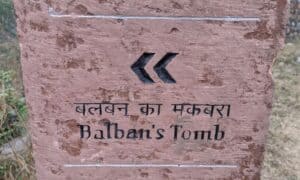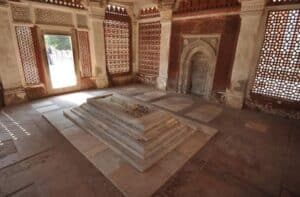The Tomb of Sultan Ghiyas-ud-din Balban, or the Tomb of Balban, is located close to the entrance gate of the Archaeological Survey Park which lies west of Mehrauli-Gurgaon Road. The Tomb of Balban is a 13th Century AD Mausoleum where the last Sultan of the Slave Dynasty was buried in 1287 AD and hence is the Sultan’s final resting place. It is a less-known tomb that the majority of the people don’t know about. But what makes it an iconic structure is the way it is designed. The way it is built and designed is a true representation of Indian Architecture. It is surely one of its’s kind.
Who was Balban?

Ghiyas-ud-din Balban was the Sultan of the Delhi Sultanate during the reign of the Mamluk Dynasty known to many as the ‘Slave Dynasty’ between 1266 AD and 1287 AD. He was born in the year 1206 AD; however, the date is unknown to a Turkish Noble who belonged to the Ilbari Tribal Clan. Balban was unfortunately captured by the Mughals as a child and sold to Ghazni Khwaja Jamal-ud-din Basri, a merchant from Baghdad. In 1232 AD, he was then bought as a Slave by Iltutmish who later released Balban from the bondage of Slavery upon royal orders of his Emperor, Qutb-ud-din Aibak, who was then, the reigning Sultan of the Delhi Sultanate.
Sultan Qutb-ud-din Aibak took great care of Balban in a manner befitting a royal prince and educated the boy. Balban further introduced a Persian Culture called ‘Zaminbos’ wherein people had to lie flat on the ground face down in front of the Emperor.
Balban conquered many neighboring regions after the defeat and demise of Razia Sultan. When Sultan Nasir-ud-din Mahmud ascended the Throne of the Delhi Sultanate, Balban was appointed as the Prime Minister of the Empire between 1246 AD and 1266 AD and married the Sultan’s daughter. Balban then ascended the Throne on 1266 AD at the age of 60 after the demise of Sultan Nasir-ud-din Mahmud since the Sultan did not have any son and was conferred the title of Ghiyas-ud-din Balban. He also introduced Silver Coins during his reign as the Ruler of the Delhi Sultanate.
Ghiyas-ud-din Balban ruled Delhi up till 1287 AD and upon his death; the Throne was succeeded by his grandson, Muiz-ud-din Qaiqabad, who ruled only for three years between 1287 AD and 1290 AD. Due to his incompetence and weakness, the Delhi Sultanate was eventually seized by Jalal-ud-din Firuz Khilji in 1290 AD, hence, ending the reign of the Slave Dynasty and commencing the reign of the Khilji Dynasty.
How was the Tomb of Balban established?
After the demise of Ghiyas-ud-din Balban in 1287 AD, he was buried with royal honor in the area known today as the Archaeological Survey Park at Mehrauli in South Delhi. The Tomb is almost in a state of ruins and lacks the extensive ornamental style seen in the Tomb of Iltutmish who was the Master of Balban. What exists today is a rubble square chamber that surrounds the Grave of Balban opened to the sky with arched openings on all sides. The Tomb represents the first Indo-Islamic architectural style to have been built in this country and was in fact discovered only during the mid-20th Century AD.
As you walk towards the east of Balban’s Tomb, you will notice a rectangular structure also in complete ruins which are believed to be the Tomb of Khan Shahid who was the son of Sultan Balban.
How to reach the Tomb of Balban?
The tomb is open all days from 6 a.m. to 6 p.m. in the evening and there is no entry fee. There are various ways by which you can reach the tomb, if you are traveling from Delhi only, you can board DTC bus number 505. Another convenient way to reach is by the metro. You can board the yellow line metro from Kashmiri Gate to Hauz Khs village and then switch to the blue line from Hauz Khas to Chattarpur. The tourists can hire taxis or auto rickshaws to reach the tomb.
Although the structure is mostly ruined by the course of time and weather, you can still visit the Tomb of Balban, if you love reading and acknowledging history.
- Guardians of the Game: The Critical Role and Unwavering Necessity of Fraud Verification Companies in Korea’s Toto Ecosystem - February 20, 2024
- Discover These Top Scenic Treks near Delhi - January 31, 2024
- Delhi Travel Tips - June 22, 2021

